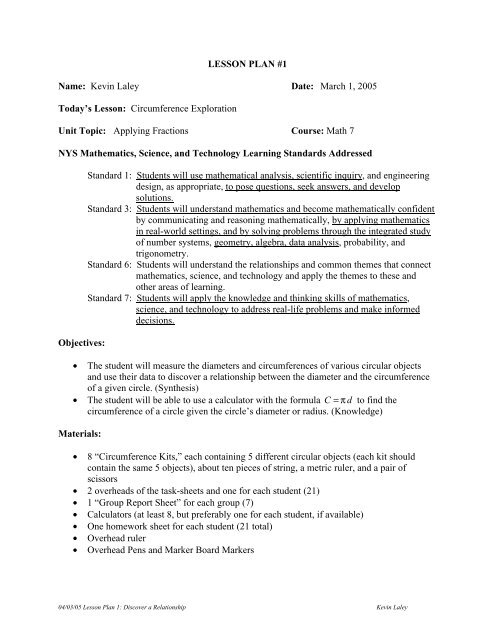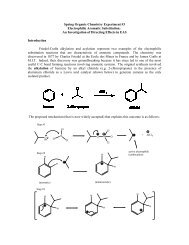Lesson Plan 1 - Discover a Relationship
Lesson Plan 1 - Discover a Relationship
Lesson Plan 1 - Discover a Relationship
Create successful ePaper yourself
Turn your PDF publications into a flip-book with our unique Google optimized e-Paper software.
solving a problem such as this in our exploration today. (Anticipatory set should take about 5minutes.)<strong>Lesson</strong> Body:Set-UpBefore dividing the class into groups, explain to the students what will be expected of them inthe class period. First, I will give one task sheet (“Circumference Exploration”) to each student. Iwill then tell them that they will be working in groups of three, which have been pre-assignedahead of class, to measure the diameter and circumference of the five objects in their“Circumference Kits.” (These are the bags containing five circular objects, a metric ruler, string,and a pair of scissors that have been prepared before class.) Next, I will take one of these objectsfrom that bag and model how the students are to measure the diameter and circumference. (Usinga piece of string and an object from the bag, hold one end of the string on one edge of the circle,and pull the string tight across the object so that it passes through the center of the circle andtouches the opposite edge of the circle. Holding both ends of the string where they meet the edgeof the circle, place the string up to the metric overhead ruler and show how measuring the lengthof the string between these two points gives us a measurement for the diameter of the object.Similarly, pull the string tight so that it goes around the circumference, or edge, of the circle,holding the string at its starting and end point. Then show that measuring the distance betweenthese two points of the string gives us a measurement for the circumference of the circle. Thisshould take about 5 minutes.ExperimentingBreak the class into groups of three people. (For our class of 21, there will thus be 7 groups).Make sure each “team” pulls their desks together so that they are facing one another. Ask onemember of each team to come to the front of the room and get a “Circumference Kit” and “groupreport sheet” for the team and another person from each group to get enough calculators for eachindividual in their team. Once this is done, instruct each team to designate one person to measurethe diameter of each object, another person to measure the circumference of each object, and athird person to record all the values. (This third person will also “copy” their data on the groupreport sheet.) If one group finishes before the others, have them switch roles so that they “check”each others’ measurements. This should take approximately 10 minutes and then another 2minutes to discuss what students found in the exploration. (Ask if anyone experienced anydifficulties, how they overcame these difficulties, or if they had a chance to check each other’smeasurements. Some students may have trouble “eyeballing” the center of the circle for thediameters or getting the string to stretch around the circumference.)Reflecting and ExplainingWith the teams, now assembled as a whole class group, put the task sheet on the overhead andask one group what they got for the circumference of object A, the diameter of object A, and theratio of the circumference to the diameter of object A. Then, ask another group to volunteer their04/03/05 <strong>Lesson</strong> <strong>Plan</strong> 1: <strong>Discover</strong> a <strong>Relationship</strong> Kevin Laley
data for Object B and so on until one set of measurements for each of the objects is recorded. (Iftime is beginning to run short, you may choose to only collect data from the first few objects.)At this time, collect the “group report sheets” from each group. The students do not need to copydown the data from the overhead, because I will type up a sheet with each group’s data alongwith the class averages for the measurements. This “summary sheet” will be handed out at thebeginning of the following class and will serve as a quick review of the material covered todayand will allow each student to have a “complete report” of our findings.This “class reflection” should take no longer than 10 minutes.Hypothesizing and ArticulatingAsk, (1) “What do you notice about the quotients you calculated?” (Hopefully, students willnotice that all of them are relatively close to 3 or 3.14.) If for some reason the data is off, explainto the class that the values are supposed to all be equal to 3.14.Next, ask students (2) “Why are the ratios we calculated not exactly equal to 3.14?” orequivalently, “What are some possible sources of error in the exploration.” (Error in estimatingthe center of the circle, not correctly measuring the length of the string with the ruler, using“stretchy string” etc …).This should take about 5 minutes.For homework, I will ask the students to write a short journal entry detailing their experiencewith today’s exploration and what they gained from it.Verifying and RefiningNow that the class has been told that the circumference of any circle divided by its diameteralways equals approximately 3.14, tell them that mathematicians have given a special name tothis number, Pi (π ). Stress that 3.14 is merely an approximation for this number and that itactually goes on forever, never repeating or terminating. (This is called an irrational number.)(3) Ask the students “Can you write an equation for the circumference of a circle given itsdiameter?” (Give them one or two minutes for contemplation before asking if any of them have asuggestion.) The correct response should look something like the following:circumferencediamterThis should take about 5-7 minutes.= π or circumference= π d or C = π d .04/03/05 <strong>Lesson</strong> <strong>Plan</strong> 1: <strong>Discover</strong> a <strong>Relationship</strong> Kevin Laley
Group MembersDate:Circumference Exploration – Group Report SheetDirections: Have the data recorder from your group copy the measurements you obtained fromyour exploration in the table below. This sheet will be handed it at the end of the class.Object Circumference (cm) Diameter (cm) Ratio (C ÷D)04/03/05 <strong>Lesson</strong> <strong>Plan</strong> 1: <strong>Discover</strong> a <strong>Relationship</strong> Kevin Laley
Name:Date:Circumference HomeworkWhat number is symbol π approximately equal to? Explain what the significance ofthis number is in regards to the circumference and the diameter of a circle.Based on our findings from class, write a formula for finding the circumference ofa circle:Calculate the circumference of the following circles:r = 15r = 1Try to find the perimeter of this object:4 cm10 cm10 cm4 cm04/03/05 <strong>Lesson</strong> <strong>Plan</strong> 1: <strong>Discover</strong> a <strong>Relationship</strong> Kevin Laley
















